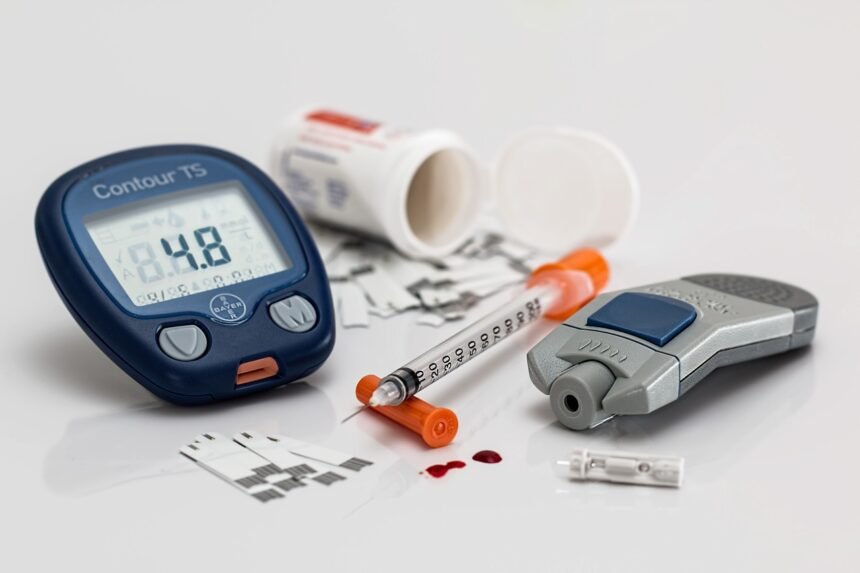Welcome to “All that You Want to Be aware of Diabetes,” an enlightening aide that dives into the different aspects of this pervasive ailment. Diabetes, a metabolic issue influencing millions around the world, requests an exhaustive comprehension for successful administration and counteraction. In this article, we’ll investigate the sorts, causes, side effects, conclusion, and medicines of diabetes, furnishing you with fundamental bits of knowledge to explore this mind boggling condition.
Whether you’re seeking to enhance your knowledge or actively managing diabetes, our concise yet thorough overview will guide you through the key aspects of living with and addressing this health concern. Let’s embark on a journey to unravel the intricacies of diabetes and empower ourselves with knowledge for a healthier future.
1. Understanding Diabetes
1.1 What is Diabetes?
Diabetes, a persistent ailment, emerges when the body faces difficulties in managing glucose (glucose) levels really. Glucose, got from the food we devour, fills in as the essential energy source. Insulin, a chemical created by the pancreas, works with the retention of glucose into cells for energy usage. In diabetes, this unpredictable equilibrium is upset, prompting raised glucose levels.
- Definition and Overview
Diabetes is portrayed by tireless high glucose levels, coming about because of insufficient insulin creation or the body’s failure to really utilize insulin. This metabolic brokenness can have serious results on the off chance that not oversaw properly.
1.1.2 Types of Diabetes
Diabetes manifests in various types, each with distinct characteristics:
1.1.2.1 Type 1 Diabetes
- In Type 1 diabetes, the immune system mistakenly attacks and destroys insulin-producing cells in the pancreas. This type often develops early in life, requiring lifelong insulin therapy.
1.1.2.2 Type 2 Diabetes
- Type 2 diabetes primarily occurs in adulthood and is associated with insulin resistance, where the body’s cells do not respond effectively to insulin. Lifestyle factors, genetics, and obesity contribute to its development.
1.1.2.3 Gestational Diabetes
- Gestational diabetes emerges during pregnancy when the body cannot produce sufficient insulin to meet increased demands. While it usually resolves after childbirth, it increases the risk of Type 2 diabetes later in life.
1.1.2.4 Prediabetes
- Prediabetes indicates elevated blood sugar levels that are not yet in the diabetic range. It serves as a warning sign, offering an opportunity for lifestyle changes to prevent progression to Type 2 diabetes.
1.1.3 Other Types of Diabetes
- Beyond the common types, there are rarer forms, such as monogenic diabetes and secondary diabetes, each with its unique causes and considerations.
Understanding the nuances of these diabetes types lays the foundation for effective management and prevention, which we’ll further explore in subsequent sections. In the journey to comprehending diabetes, knowledge is key to navigating the complexities of this prevalent health condition.
Top of Form
2. Symptoms and Diagnosis
2.1 Recognizing Symptoms
Diabetes often manifests with specific signs and symptoms, alerting individuals to potential health concerns. Recognizing these indicators is crucial for prompt diagnosis and intervention.
2.1.1 General Symptoms
- Increased thirst and hunger
- Frequent urination
- Unexplained weight loss
- Fatigue and weakness
- Blurred vision
2.1.2 Symptoms in Men
- Erectile dysfunction
- Reduced muscle mass
- Decreased libido
2.1.3 Symptoms in Women
- Irregular menstrual cycles
- Polycystic ovary syndrome (PCOS)
- Recurrent yeast infections
2.1.4 Gestational Diabetes Symptoms
- Typically asymptomatic; diagnosed through routine screening during pregnancy
- Increased risk for gestational diabetes if overweight, older than 25, or have a family history of diabetes
2.2 Diagnostic Procedures
Timely and accurate diagnosis is pivotal for effective diabetes management. Diagnostic procedures focus on assessing blood sugar levels and identifying potential complications.
2.2.1 How is Diabetes Diagnosed?
- Fasting Blood Sugar Test: Measures blood glucose levels after an overnight fast.
- Oral Glucose Tolerance Test (OGTT): Evaluates how the body processes glucose after consuming a sugary solution.
- A1C Test: Provides an average blood sugar level over the past two to three months.
- Random Blood Sugar Test: Measures glucose levels at any time, regardless of when the individual last ate.
2.2.2 Blood Tests for Diabetes
A1C (or Glycated Hemoglobin) Test:
- Reflects average blood sugar levels over several months.
- A level of 6.5% or higher indicates diabetes.
Fasting Blood Sugar Test:
- A fasting blood sugar level of 126 mg/dL or higher suggests diabetes.
Glucose Tolerance Test:
- A two-hour blood sugar level of 200 mg/dL or higher indicates diabetes.
Random Blood Sugar Test:
- A blood sugar level of 200 mg/dL or higher, along with diabetes symptoms, suggests the condition.
Antibody Test:
- Detects specific antibodies associated with Type 1 diabetes.
2.2.3 Urine Test for Diabetes
- Assesses the presence of ketones, glucose, and protein in urine, providing additional insights into diabetes management.
Understanding the symptoms and undergoing appropriate diagnostic tests empowers individuals and healthcare professionals to initiate timely interventions and adopt suitable management strategies. The following area will dive into the inconveniences and forecast related with diabetes, revealing insight into the potential difficulties people might confront.
3. Complications and Prognosis
3.1 Diabetes Complications
Diabetes, when not successfully made due, can prompt a scope of difficulties influencing different organs and frameworks in the body. Understanding these complications is crucial for proactive healthcare management.
3.1.1 Acute Complications
Hypoglycemia (Low Blood Sugar):
- Occurs when blood sugar levels drop below normal.
- Symptoms include shakiness, dizziness, sweating, and confusion.
- Emergency treatment involves consuming glucose or sugary foods.
Hyperglycemia (High Blood Sugar):
- Results from elevated blood sugar levels.
- Symptoms include increased thirst, frequent urination, and fatigue.
- Long-term hyperglycemia can contribute to organ damage.
Diabetic Ketoacidosis (DKA):
- A life-threatening condition resulting from a lack of insulin.
- Symptoms include dehydration, nausea, and abdominal pain.
- Immediate medical attention is necessary.
3.1.2 Long-term Complications
Cardiovascular Complications:
- Increased risk of heart disease, stroke, and high blood pressure.
- Regular monitoring and lifestyle interventions are essential.
Kidney Disease (Nephropathy):
- Diabetes is a leading cause of kidney failure.
- Management includes blood pressure control and regular kidney function monitoring.
Neuropathy:
- Nerve damage leading to pain, tingling, and numbness.
- Foot care and blood sugar control are crucial to prevent complications.
Eye Complications (Retinopathy):
- Diabetes is a major cause of blindness.
- Regular eye exams and blood sugar control are vital for prevention.
3.2 Prognosis and Outlook
Understanding the prognosis of diabetes is essential for individuals and their healthcare providers to plan effective management strategies.
3.2.1 Prognosis for Diabetes
Type 1 Diabetes:
- Requires lifelong insulin therapy.
- Advances in insulin delivery methods enhance management.
Type 2 Diabetes:
- Management includes lifestyle changes, medications, and sometimes insulin.
- Long-term outcomes depend on effective blood sugar control.
Gestational Diabetes:
- Typically resolves after childbirth, but increases the risk of Type 2 diabetes.
- Postpartum monitoring is essential.
Prediabetes:
- Reversible with lifestyle modifications.
- Effective preventive measures can halt progression to diabetes.
Understanding the potential complications and prognosis associated with diabetes emphasizes the importance of proactive management and regular healthcare monitoring. The following section will delve into the various approaches to managing and treating diabetes, providing practical insights for individuals facing this condition.
4. Management and Treatment
4.1 Treatment Approaches
Effectively managing diabetes involves a multifaceted approach that addresses lifestyle factors, medications, and, in some cases, insulin therapy. Tailoring treatment to the specific type of diabetes is crucial for optimal outcomes.
4.1.1 Type 1 and 1.5 Diabetes Treatment
Insulin Therapy:
- Essential for individuals with Type 1 diabetes and some with Type 1.5 (LADA – Latent Autoimmune Diabetes in Adults).
- Various insulin delivery methods, including injections and insulin pumps, offer flexibility in management.
4.1.2 Type 2 Diabetes Treatment
Lifestyle Modifications:
- Emphasis on healthy eating, regular physical activity, and weight management.
- May include oral medications to improve insulin sensitivity.
Oral Medications:
- Metformin is a commonly prescribed medication that helps control blood sugar.
- Other classes of medications target different aspects of glucose regulation.
4.1.3 Gestational Diabetes Treatment
Monitoring Blood Sugar:
- Regular monitoring to ensure blood sugar levels remain within a healthy range.
- Dietary adjustments to manage glucose levels during pregnancy.
4.2 Diabetes and Lifestyle
Lifestyle plays a pivotal role in diabetes management, influencing blood sugar control and overall well-being.
4.2.1 Exercise and Diabetes
Types 1 and 1.5 Diabetes:
- Regular exercise improves insulin sensitivity.
- Individualized plans considering insulin adjustments.
Type 2 Diabetes:
- Physical activity aids in weight management and improves glucose utilization.
- Consistency is key for sustained benefits.
Gestational Diabetes:
- Moderate exercise can help manage blood sugar levels during pregnancy.
- Consultation with healthcare providers for personalized exercise plans.
4.2.2 Diet and Diabetes
Types 1 and 1.5 Diabetes:
- Focus on balanced meals to match insulin needs.
- Carbohydrate counting and meal timing are essential.
Type 2 Diabetes:
- Emphasis on a balanced diet, portion control, and carbohydrate monitoring.
- Dietary modifications to achieve weight goals.
Gestational Diabetes:
- Monitoring carbohydrate intake and distributing meals evenly throughout the day.
- Consultation with a nutritionist for personalized dietary plans.
4.3 Medications and Insulin
A variety of medications aim to address the underlying factors contributing to diabetes.
4.3.1 Insulin Use and Dosage
- Individualized Approach:
- Dosage and type of insulin vary based on factors like lifestyle, diet, and activity level.
- Continuous communication with healthcare providers for adjustments.
4.3.2 Other Medications
Metformin:
- Commonly prescribed for Type 2 diabetes.
- Improves insulin sensitivity and reduces glucose production in the liver.
SGLT2 Inhibitors and GLP-1 Receptor Agonists:
- Newer classes of medications that aid in glucose control.
- May be prescribed in addition to other treatments.
Understanding the different treatment modalities engages people with diabetes to team up successfully with their medical services group in making a customized administration plan. In the following segment, we’ll investigate the significance of everyday administration and checking for people living with diabetes.
5. Living With Diabetes
5.1 Daily Management
Viable day to day administration is fundamental for people living with diabetes to keep up with ideal wellbeing and forestall complexities.
5.1.1 Self-Monitoring Blood Glucose
How to Check Blood Sugar:
- Use a blood glucose meter to measure blood sugar levels regularly.
- Log results to identify patterns and trends.
Continuous Glucose Monitoring (CGM):
- Provides real-time blood sugar data.
- Offers insights into glucose fluctuations throughout the day.
5.1.2 High and Low Blood Sugar
Hyperglycemia (High Blood Sugar):
- Addressed by adjusting insulin doses, reviewing diet, and increasing physical activity.
- Recognizing symptoms and acting promptly is crucial.
Hypoglycemia (Low Blood Sugar):
- Treated with fast-acting carbohydrates like glucose tablets or fruit juice.
- Regular monitoring to prevent severe hypoglycemic episodes.
5.2 Diabetes During Pregnancy and in Children
Special considerations are needed for managing diabetes during pregnancy and in children.
5.2.1 Diabetes in Pregnancy
Gestational Diabetes:
- Regular monitoring of blood sugar levels.
- Adhering to dietary recommendations and, if necessary, medication.
Risks to Newborns:
- Close monitoring for potential complications in newborns.
- Collaborative care involving obstetricians and pediatricians.
Pre-gestational Diabetes:
- Planning for pregnancy with optimal blood sugar control.
- Consistent monitoring and adjustments during pregnancy.
Persistence of Gestational Diabetes:
- Continued monitoring postpartum.
- Lifestyle modifications to prevent the onset of Type 2 diabetes.
5.2.2 Diabetes in Children
Type 1 Diabetes in Children:
- Parental involvement in daily management.
- Age-appropriate education for children on self-care.
Type 2 Diabetes in Children:
- Emphasis on lifestyle changes, including diet and exercise.
- Family involvement in creating a supportive environment.
Understanding the complexities of day to day administration is critical for people with diabetes to lead satisfying and solid lives. In the accompanying area, we’ll investigate preventive measures and the job of local area support in overseeing and tending to diabetes.
6. Prevention and Community Support
6.1 Diabetes Prevention
While some risk factors for diabetes are beyond individual control, several preventive measures can reduce the likelihood of developing the condition.
6.1.1 Preventive Measures
Maintain a Healthy Lifestyle:
- Adopt a balanced diet rich in fruits, vegetables, and whole grains.
- Engage in regular physical activity to manage weight and improve insulin sensitivity.
Regular Health Check-ups:
- Monitor blood sugar levels during routine health check-ups.
- Early detection and intervention can prevent the progression to diabetes.
Manage Stress:
- Incorporate stress-reducing activities like meditation and exercise.
- Chronic stress can contribute to insulin resistance.
6.2 Diabetes Community
Being part of a supportive community is invaluable for individuals dealing with diabetes. Accessing information, sharing experiences, and gaining emotional support can significantly enhance the overall management of the condition.
6.2.1 Seeking Healthcare:
- Regular visits to healthcare providers for monitoring and adjustments.
- Open communication about challenges and concerns with healthcare professionals.
6.2.2 Diabetes Support Groups:
Instagrammers:
- Follow reputable Instagram accounts for daily tips, recipes, and motivation.
- Engage with a community that shares experiences and success stories.
Podcasts:
- Listen to podcasts featuring expert advice and personal narratives.
- Stay informed about the latest developments in diabetes management.
Non-Profits:
- Connect with non-profit organizations focused on diabetes.
- Access resources, educational materials, and community events.
A sense of community fosters a supportive environment, empowering individuals to navigate the challenges of diabetes more effectively. Whether through online platforms, podcasts, or local support groups, finding a community can contribute to better mental and emotional well-being.
Conclusion:
In conclusion, “Everything You Need to Know about Diabetes” serves as a comprehensive guide, offering a detailed exploration of the complexities surrounding this prevalent health condition. From understanding the various types of diabetes and recognizing symptoms to proactive management, treatment approaches, and the crucial role of community support, this guide provides essential insights for individuals and their loved ones.
By emphasizing preventive measures, daily management strategies, and the significance of being part of a supportive community, the aim is to empower those affected by diabetes to navigate their journey with confidence and resilience. As we collectively work towards raising awareness, fostering understanding, and promoting a proactive approach to health, this guide stands as a valuable resource for anyone seeking knowledge and guidance on the path to effectively managing and living with diabetes.










